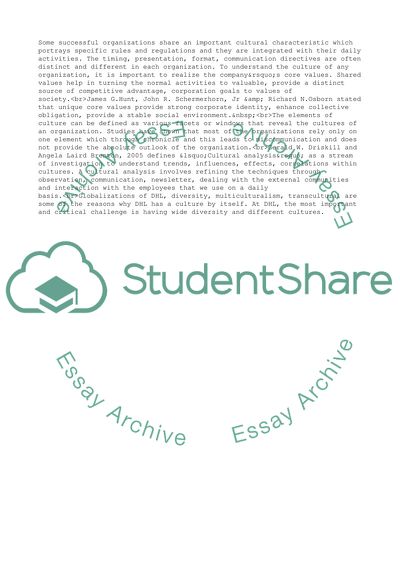Cite this document
(Cultural Analysis of DHL Case Study Example | Topics and Well Written Essays - 4500 words, n.d.)
Cultural Analysis of DHL Case Study Example | Topics and Well Written Essays - 4500 words. Retrieved from https://studentshare.org/business/1731880-conduct-an-analysis-of-the-culture-in-any-organisation-of-your-choice-why-is-the-culture-as-it-is-in-what-ways-do-you-think-the-culture-helps-or-hinders-the-strategic-development-of-that-company-dhl-wwwdhlcom
Cultural Analysis of DHL Case Study Example | Topics and Well Written Essays - 4500 words. Retrieved from https://studentshare.org/business/1731880-conduct-an-analysis-of-the-culture-in-any-organisation-of-your-choice-why-is-the-culture-as-it-is-in-what-ways-do-you-think-the-culture-helps-or-hinders-the-strategic-development-of-that-company-dhl-wwwdhlcom
(Cultural Analysis of DHL Case Study Example | Topics and Well Written Essays - 4500 Words)
Cultural Analysis of DHL Case Study Example | Topics and Well Written Essays - 4500 Words. https://studentshare.org/business/1731880-conduct-an-analysis-of-the-culture-in-any-organisation-of-your-choice-why-is-the-culture-as-it-is-in-what-ways-do-you-think-the-culture-helps-or-hinders-the-strategic-development-of-that-company-dhl-wwwdhlcom.
Cultural Analysis of DHL Case Study Example | Topics and Well Written Essays - 4500 Words. https://studentshare.org/business/1731880-conduct-an-analysis-of-the-culture-in-any-organisation-of-your-choice-why-is-the-culture-as-it-is-in-what-ways-do-you-think-the-culture-helps-or-hinders-the-strategic-development-of-that-company-dhl-wwwdhlcom.
“Cultural Analysis of DHL Case Study Example | Topics and Well Written Essays - 4500 Words”, n.d. https://studentshare.org/business/1731880-conduct-an-analysis-of-the-culture-in-any-organisation-of-your-choice-why-is-the-culture-as-it-is-in-what-ways-do-you-think-the-culture-helps-or-hinders-the-strategic-development-of-that-company-dhl-wwwdhlcom.


